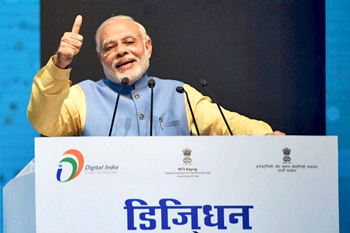New Delhi, Dec 31: With his gaze fixed on UP and the larger Dalit constituency, PM Narendra Modi launched on Friday an app whose acronym Bhim (Bharat Interface for Money) beamed a political message to the socially disadvantaged.
 The app, which seeks to ensure easy, fast and secure digital transactions, saw Modi invoking Dalit icon B R Ambedkar several times at an event here as he argued digitalisation would empower the poor -rather than disadvantage them, as maintained by some demonetisation critics.
The app, which seeks to ensure easy, fast and secure digital transactions, saw Modi invoking Dalit icon B R Ambedkar several times at an event here as he argued digitalisation would empower the poor -rather than disadvantage them, as maintained by some demonetisation critics.
The acronym is reminiscent of pro-Dalit outfit BSP's "Jai Bhim" slogan and carries an association with Dalit movements. Apart from challenging BSP in the UP polls, the move seeks to counter the flak BJP received over violence against Dalits in some of the states it rules and also the Rohith Vemula suicide. The mantra of Dr Ambedkar was to work for uplift of the poor. And the biggest power of technology is that it can empower the poor," Modi said as he extolled the app's feature that allows a thumb print to activate it. Earlier, use of a thumb impression for legal purposes was a sign of illiteracy (angutha chhaap) but technology and the new app could turn this into an instrument of personal empowerment, the PM said. "Your thumb is your bank now. It has become your identity now."
The political application of Bhim was all too evident as the launch of the app comes just before the crucial assembly elections in UP where BJP is struggling to detach the Dalits from BSP chief Mayawati. The social enlargement Modi had in mind seemed to be an attempt to expand the constituency beyond the party's more traditional catchment of upper castes to the less well-off OBCs and SCs.
Addressing the gathering of party workers and officials, Modi recalled Ambedkar as an economist and even went on to utter "Bahujan Hitay Bahujan Sukhay".
"The RBI was born on principles he (Ambedkar) wrote in his thesis. How the federal structure should run economically. The Finance Commission that was formed for this purpose was a result of his principles. If there is one person whose contribution stands out in India's economic framework, it is Babasaheb Ambedkar's," Modi said.
"No matter how far a country has gone, even for them, they have to go to Google, ask Google Guru what is Bhim. At first, they will see Bhim from Mahabharat. If they dig deeper, they will find Bharat Ratna Bhimrao Ambedkar. This was the goal of his life, to empower the poor. And this is what the app will do. This is the poor's treasure. This will empower the poor, farmers, tribal people," the PM said.
Arguing that Bhim app will bring Ambedkar centrestage, Modi said, "Be it a smartphone or feature phone of Rs 1,000-1,200, Bhim app can be used. There is no need to have internet connectivity .One only needs a thumb" Modi's dedication of the app to Ambedkar is a part of his strategy over the past year to seek to position BJP as being truly mindful of his legacy . He has repeatedly attacked Congress for ignoring and even downplaying Ambedkar in comparison with Nehru-Gandhi leaders.
BJP and Sangh Parivar have tried to appropriate a piece of the Dalit icon's legacy as the Modi government accelerated construction of an Ambedkar memorial in Delhi.
BJP government in Maharashtra decided to buy the London flat where Ambedkar stayed and the Sangh Parivar celebrated the birth centenary of the framer of the Constitution on a big scale through the year.
But BJP suffered setbacks because of Hyderabad Central University student Rohith Vemula's suicide and the atrocity committed by gau rakshaks on Dalits at Una in Gujarat. But the incidents have not fazed BJP and Sangh Parivar as only on Thursday, the government relaxed guidelines to facilitate the constriction of Ambedkar memorial in Mumbai. The government also plans to announce the mega draw of Rs 1 crore under "Lucky Grahak Yojana" and "DigiDhan Vyapar Yojana" on April 14, the birth anniversary of Ambedkar.





Comments
In India Feku is acting like BHIM and Arjuna ....But, but Google and You tube have placed Modi in the list of top 10 CRIMINALS of the world ....
Add new comment